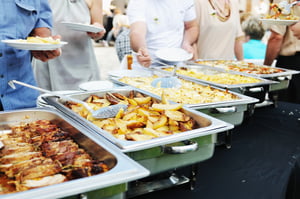The festive season is here. And few will be more stressed about that than food service providers entering their busiest weeks of the year. The combination of peak demand, long hours, new menus and tired staff creates a pressure cooker where standards can slip. It’s no wonder that food safety risks rise.
It's an important period for profitability but there can be unforeseen costs.
Cases of food poisoning always increase above average during Thanksgiving, Christmas and New Year. Many cases will stem from domestic cooking errors, but not all. Professionals involved in catering, hospitality and food supply will be acutely aware of the consequences of any cases being traced back to their business.
Let’s look at the major food safety risks to be aware of – and what food service providers can do to minimise the chances of a nasty incident.
When services are stretched beyond their usual day-to-day operations, there's a higher possibility of something going wrong.
Prevention is key and that means embedding good processes and ensuring they are followed at all times. It’s also important that kitchen teams can provide evidence of best practice for regulatory inspections and any follow-up investigations that take place.
Campylobacter is one of the biggest food safety risks
Campylobacter is one of the most common sources of food poisoning. Tens of thousands of cases are reported every year and many more go undiagnosed. The most extreme cases can result in hospitalisation and even death, in rare circumstances. Poultry is the most common source of contamination and its potential presence in turkey means it is often nicknamed ‘the Christmas bug’. To reduce this food safety risk, take steps to prevent cross contamination and keep a close eye on cooking times. Clear instructions for staff, including prompts and reminders, are key.
Personal hygiene is key to preventing Staphylococcus
Staphylococcus arises when people are involved in food preparation. It is a naturally occurring food poisoning bacteria found in an estimated 40% of people’s noses, mouths and throats, as well as 15% of the population's skin. Staphylococcus is commonly transferred to food that involves a high degree of handling, such as sandwiches and salads, where staff have poor personal hygiene habits. Unwashed hands, coughing and sneezing and uncovered cuts can all be common culprits. To reduce this food safety risk, make sure masks, gloves and first aid kits are readily available and keep staff aware of their obligations.
Take care with chilled storage to reduce food safety risks
The storage of chilled and frozen food is crucial to reducing food safety risks. Problems that can arise during the festive period include fridge and freezer doors being left open accidentally by busy kitchen staff. Winter weather also increases the risk of power cuts that, if occurring overnight, may not be detected until the following morning – with food deteriorating in the interim. Regular precautionary temperature checks may also be missed due to the heavy demands of peak service. Food service providers may also find that existing storage space is insufficient for the stock they need to carry – in which case ordering extra units becomes necessary. Automated temperature monitoring systems use IoT connected sensors to check storage conditions continuously. They are growing in popularity not only because they ensure 24/7 monitoring but they also deliver alerts when variance occurs, so food can be moved to prevent any food safety risk. In addition, automated monitoring takes the manual checking burden away from staff and automatically generates a digital audit trail for compliance and inspections.
Hot-hold food storage deserves special attention
Catering for large numbers often increases the need for hot-hold food storage but maintaining the right temperature across the right time-span before food deteriorates is a necessity. It is recommended that hot food be kept at 63°C or above, except for certain exceptions. Official guidelines specify that food that has not been used within two hours, should either be reheated until it is steaming hot and put back in hot holding or chilled down as quickly as possible to 8°C or below. If it has been out for more than two hours, the food should be thrown away. Specialised hot-hold sensors provide constant temperature measurements and alerts. Systems such as Checkit also incorporate workflows so that staff are notified when the safe period of hot-holding is almost finished. This enables frontline teams to take appropriate action at the right time.
Casual staff need to be aware of food safety risks
Another food safety risk to consider over the festive season is the increased presence of casual or temporary staff to cover peak periods. They may be unfamiliar with food safety guidance and specific best-practice hygiene rules in a particular kitchen. What’s more, there’s very little time for training. Paper checklists and forms are easily lost or damaged in busy kitchens. Digital assistants such as Checkit are replacing paperwork by providing on-the-spot prompts and guidance directly to individuals via mobile devices. Guidance is delivered specifically according to the time, location and job status of the individual. Actions are logged and securely stored in the cloud for reporting purposes. As a result, best practice can be identified and rewarded while areas of concern can be addressed before they become problematic in terms of food safety risk.
Overall, it’s important that food service providers assess their operations, identify areas of risk and put steps in place to maintain best practice. Doing that means one less thing to worry about as the festivities come into full flow.


